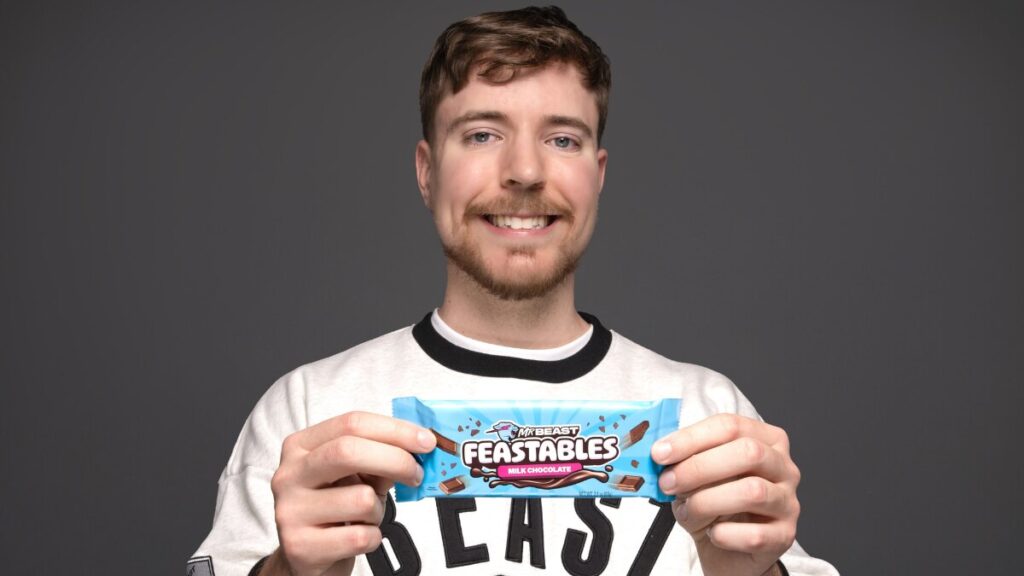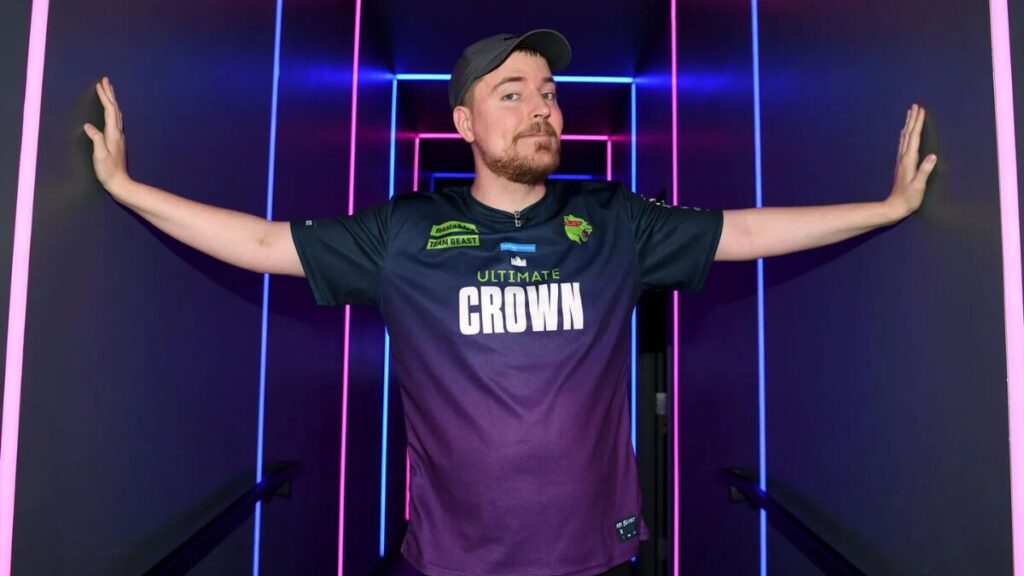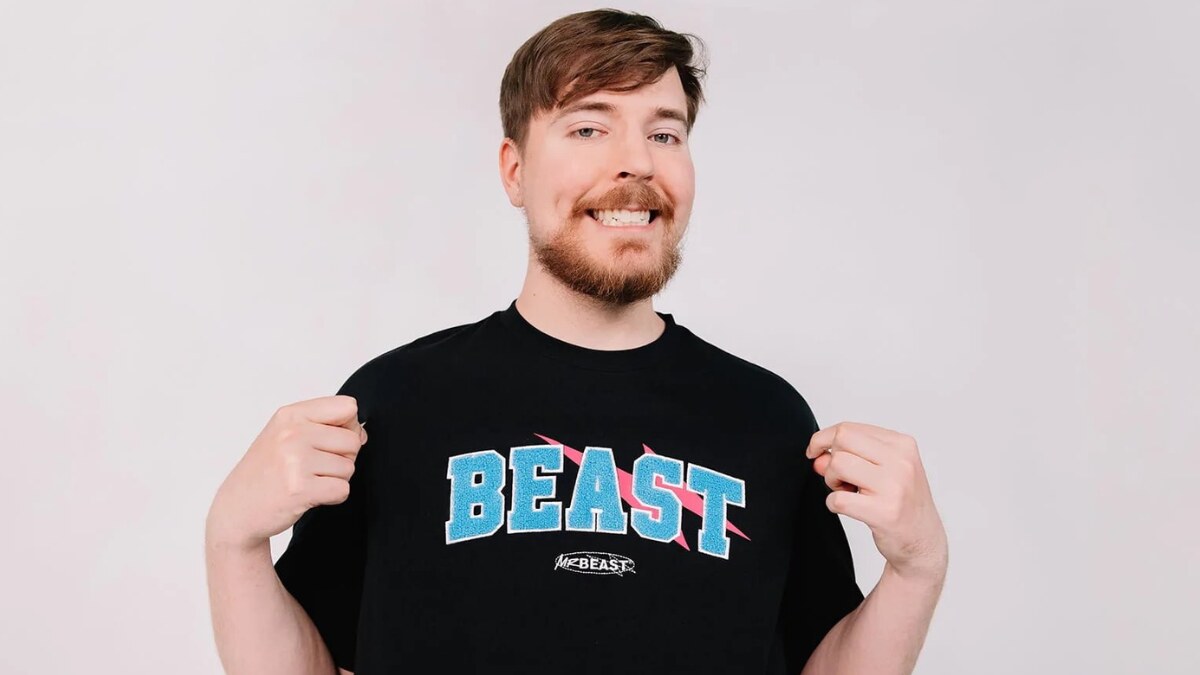The camera pans over a warehouse the size of a football field. Pallets of chocolate bars stacked to the ceiling, a video crew rigging drones for an aerial shot, a production team reviewing scripts — and at the center of it all, Jimmy Donaldson, aka MrBeast, pacing with purpose. He’s not filming a simple giveaway video. He’s directing a media machine.
By 2025, MrBeast isn’t just the most-watched YouTuber on the planet. He’s become a case study in how internet influence can evolve into a multi-industry empire — spanning content, consumer goods, philanthropy, and even equity stakes in companies you wouldn’t expect. His net worth? It’s not just a number. It’s a mirror of how the digital economy rewards scale, spectacle, and strategy.
But behind the dollar signs lies a deeper story — one of obsessive reinvestment, viral generosity, and business models built on audience trust. This article unpacks more than MrBeast’s wealth. It unpacks how he changed the rules for what a creator can be.
Breaking Down MrBeast’s Net Worth in 2025 — What the Numbers Reveal
In 2025, estimates of MrBeast’s net worth range from $1 billion, according to Celebrity Net Worth, but pinning down an exact figure isn’t as simple as Googling a number. These valuations often reflect different combinations of assets, revenue streams, and speculative projections, not a static bank balance.
Most net worth calculators fold in the major revenue pillars: high-yield YouTube ad revenue from multiple channels (some multilingual), brand deals with top-tier sponsors, massive merch sales, and, more recently, booming consumer brands like Feastables and MrBeast Burger. Unlike many influencers, Jimmy Donaldson reinvests much of his content revenue into production, so while the cash flow is enormous, his margin is intentionally lean. It’s part strategy, part obsession.
What complicates things further is how much of his fortune is tied up in private equity. MrBeast holds ownership stakes in his companies and may have silent investments in tech and creator-economy startups. That means some of his real value isn’t publicly visible or liquid, making traditional net worth comparisons misleading.
And then there are the myths: No, he doesn’t lose money on every video. No, the giveaways aren’t just stunts to drain his fortune. Quite the opposite — each viral gesture often boosts his income through views, media pickup, and product demand.
The truth? MrBeast’s wealth is fluid, diversified, and engineered for long-term scalability, not short-term flexing. And in the digital creator economy, that kind of wealth-building rewrites the rules.
The YouTube Engine That Fueled a Fortune
From Stunt Videos to Global Reach
MrBeast didn’t become the most-viewed creator on Earth by playing it safe — he did it by obsessively studying the YouTube algorithm and relentlessly outdoing himself. It all started with low-budget experiments: counting to 100,000 on camera, watching paint dry, or saying “Logan Paul” 100,000 times. These early stunts weren’t about polish — they were about endurance, absurdity, and curiosity, designed to make viewers stop scrolling.
But the real turning point came when Jimmy realized scale was the story. Instead of giving away $100, he gave away $10,000. Instead of planting a few trees, he launched Team Trees with a goal of 20 million. These weren’t just viral — they were engineered for global appeal. “Last To Leave” challenges, philanthropic giveaways, and big-budget recreations (like Squid Game) transcended language barriers.
To reach international audiences, MrBeast launched dubbed channels in Spanish, Hindi, and more, hiring native speakers to voice his content — a strategic move that multiplied reach without multiplying workload. He built a production team that now rivals small studios, complete with writers, editors, and logistics crews who treat each video like a blockbuster.
What began as clickbait evolved into a repeatable content machine that blends spectacle with generosity — and behind every viral challenge is a creator who thinks like a CEO, a showrunner, and a behavioral economist all at once.
Scaling Views into Ventures
For MrBeast, every view is more than a metric — it’s capital. Unlike most creators who treat viral success as a payday, Jimmy Donaldson treats it like seed funding. From the beginning, he’s funneled nearly all of his YouTube earnings straight back into bigger, riskier, more cinematic content. That reinvestment isn’t just about topping the last stunt — it’s how he scaled a creator channel into a production empire.
Behind the scenes, MrBeast Studios runs like a high-efficiency startup. There’s a writing team planning challenges down to the second. Dedicated logistics managers source hundreds of items for each shoot — from cars to chocolate bars to cash-filled vaults. Editors cut episodes with Netflix-level pacing. It’s not a YouTuber with a camera anymore — it’s a vertically integrated content company.
That same infrastructure now fuels his external ventures. The team that manages Feastables and MrBeast Burger was built in the echo of his YouTube playbook: scale fast, iterate constantly, and stay ruthlessly audience-focused. In many ways, he hasn’t just monetized attention — he’s turned it into an engine that launches brands, attracts investors, and creates a flywheel of content-powered commerce.

Feastables, MrBeast Burger & Beyond — Turning Brand Ideas Into Real Wealth
MrBeast didn’t just turn views into dollars — he turned them into products you can eat. In 2021, he launched MrBeast Burger, a delivery-only fast-food brand born not from a test kitchen but from a content creator’s understanding of scale. Using the ghost kitchen model, he partnered with existing restaurants to fulfill orders under the MrBeast name — no storefronts, no rent, no traditional overhead. Within months, the brand expanded to hundreds of locations, fueled entirely by hype and a single YouTube drop.
Then came Feastables — a snack company that took a more traditional route, landing on physical shelves in Walmart and Target. But even there, MrBeast defied convention. Instead of launching with broad product lines, Feastables focused on chocolate bars with bold branding and QR-code gamification tied to video content. Every wrapper was a ticket to giveaways, social challenges, or limited-edition drops. The goal wasn’t just to sell snacks — it was to build a content-connected consumer ecosystem.
Neither business relied on traditional advertising. The launch of each was built into YouTube narratives, where fans felt like insiders — participants rather than customers. In both cases, audience loyalty replaced ad spend, and MrBeast’s personality served as the brand’s trust signal.
What made these ventures stick was a deep understanding of attention economics. Where most influencers slap their name on merch, MrBeast structured real businesses with operational partners, licensing strategies, and performance incentives. He knew when to outsource logistics and when to own creative. Even more critically, he treated product launches like content launches — with trailers, hype cycles, and post-launch video follow-ups to keep the momentum alive.
By leveraging audience trust, virality mechanics, and scalable fulfillment models, MrBeast proved that creators aren’t just marketing tools — they can be founders, operators, and brand architects in their own right.
More Than Money — MrBeast’s Viral Philanthropy as a Business Multiplier
MrBeast’s generosity isn’t just altruism — it’s a form of strategic storytelling. In a creator economy oversaturated with clickbait, Jimmy Donaldson realized that generosity scales better than drama. When he pays for 1,000 people to get life-changing eye surgery, it’s not just a kind act — it’s a globally viral moment that drives tens of millions of views, attracts media coverage, earns brand trust, and sells chocolate bars.
Take the 2023 video “1,000 People See for the First Time.” It was framed like a humanitarian documentary, shot with cinematic pacing, and cut to maximize emotional resonance. It exploded online. But what made it different was that it doubled as content, philanthropy, and brand positioning — all in one. This wasn’t charity as a side project. This was the product.
Similarly, in the “We Built 100 Wells in Africa” series, MrBeast’s team turned infrastructure development — typically the realm of NGOs — into YouTube narrative arcs. His crew didn’t just film aid delivery. They embedded storytelling around transformation, gratitude, and scale. The result? Millions of impressions that simultaneously boosted his image and the visibility of his sponsors.
Critics may question whether monetized charity dilutes intent. But here’s the deeper truth: in an ecosystem where attention is currency, MrBeast has built a model where doing good generates growth. It’s not exploitation — it’s an evolved form of earned media. And in the long term, that brand equity is arguably more valuable than any single video’s ad revenue.
Is this the future of digital giving? A hybrid model where philanthropy isn’t outsourced, but owned, produced, and scaled by creators themselves? MrBeast didn’t just make generosity go viral. He made it sustainable — and that may be his most important innovation of all.
Investments, Equity Stakes & Silent Wins
While Feastables and MrBeast Burger grab headlines, much of Jimmy Donaldson’s real wealth may lie in what isn’t seen on camera. Behind the scenes, he’s quietly positioned himself as a strategic investor in the creator economy — placing equity bets in companies building the infrastructure for modern digital media.
Though details are tightly held, he’s rumored to hold stakes in creator-focused platforms and monetization tools — think payment processors, merch logistics, or audience analytics startups — the kind of businesses that fuel other influencers’ growth. These aren’t flashy IPO plays; they’re utility-layer bets with long-term upside.
MrBeast is also known to negotiate equity in partnerships where other creators might take cash. Some speculate he has backend deals in video tech, platform integrations, or performance-based contracts with startup brands he features. Whether he’s hands-on varies, but the consistent theme is leverage without overextension.
This isn’t empire-building in the traditional CEO sense. It’s smart positioning — spreading influence across sectors where his name, reach, and creative instincts translate into compounding value. In a landscape where creators burn out or overspend, MrBeast seems to be playing a quieter game: longevity through infrastructure.
Compared to the Titans: MrBeast’s Net Worth vs. Other Creator Moguls
With an estimated net worth hovering between $1 billion in 2025, MrBeast ranks among the top creator-entrepreneurs on the planet — but what sets him apart isn’t just the amount. It’s how he earned it.
Unlike Logan Paul and KSI, who built their empires through performance-based ventures like Prime Energy, or Emma Chamberlain, who took the high-margin lifestyle route with Chamberlain Coffee and luxury partnerships, MrBeast has leaned into a high-volume, low-margin model — building scalable systems through YouTube and then applying those playbooks to physical goods and philanthropy.
Compare that to someone like Joe Rogan, whose Spotify deal netted him a reported $200 million. Rogan monetized access and exclusivity. MrBeast, by contrast, monetizes ubiquity with content that spans platforms, languages, and even retail shelves. One built a gate. The other built a funnel.
Then there’s PewDiePie, once the reigning king of YouTube. His empire, while culturally iconic, remained largely personality-driven. MrBeast has decentralized himself, creating a branded studio operation that doesn’t require his face in every thumbnail to succeed.
Even among creators like Ryan Trahan or Mark Rober — who also blend altruism and storytelling — MrBeast’s approach is uniquely optimized. His philanthropy model generates revenue to fund more giving, a cycle few others have achieved at scale.
In short, MrBeast isn’t just in the same league as creator moguls — he’s redefining the rulebook. His empire is built on reinvestment, infrastructure, and a high-trust relationship with viewers. Whether others can follow that blueprint depends on more than content — it requires vision, operational grit, and a willingness to never coast.
Inside MrBeast’s Mindset: The Relentless Drive Behind the Empire
“I just obsess over making the best videos possible,” Jimmy Donaldson once said — and it wasn’t just a soundbite. For MrBeast, the pursuit of virality is less about fame and more about optimization. He’s spent years fine-tuning titles, thumbnails, pacing, and retention curves like a data scientist in a filmmaker’s body.
By his admission, he watches his videos back dozens of times, looking for flaws. He runs thumbnail A/B tests like product trials. In earlier interviews, he’s talked about pulling 18-hour days, sometimes sleeping in the studio, completely absorbed in scripting the next big idea. The money, he’s said repeatedly, just gives him more room to experiment.
But that obsession comes at a cost.
Friends and collaborators have quietly acknowledged the toll — the burnout cycles, the endless creative pressure, the stress of feeding a content machine that never stops. He’s admitted to losing touch with everyday life at times, joking that he has no hobbies because “making videos is the hobby.”
Still, it’s this intensity — the willingness to live inside the content — that’s made his empire possible. Unlike many influencers who pivot out once they hit it big, MrBeast remains in the trenches, fine-tuning frame edits and scripting sponsor shoutouts like it’s still 2017.

What Spending a Day at the MrBeast Warehouse Taught Me About Modern Media
The first thing that hit me wasn’t the scale — it was the pace. Inside the MrBeast warehouse, the air buzzes with the kind of focused urgency you’d expect from a tech startup minutes before launch. Dozens of crew members hustle between sound stages and loading docks, while massive whiteboards map out logistics for upcoming giveaways: cars, pallets of Feastables, a giant inflatable obstacle course. It’s chaos, but controlled.
I shadowed one of the production leads, who casually told me they were shooting five videos in parallel — each with six-figure budgets and moving parts that would make a film producer sweat. At one point, someone ran by holding a rubber duck the size of a sofa. No one blinked.
What surprised me most was how lean the creative process was. Despite the scale, Jimmy was still hands-on — reviewing footage in real-time, tweaking scripts on the fly, obsessing over thumbnail concepts like they were movie posters. It wasn’t glamorous. It was gritty, high-speed, and deeply process-driven.
By the end of the day, I wasn’t thinking about YouTube anymore. I was thinking about media at large — how this warehouse in North Carolina felt more innovative than most studio lots I’ve seen. MrBeast isn’t just a creator. He’s quietly building the future of entertainment — one high-stakes idea at a time.
What’s Next in 2025 and Beyond — MrBeast’s Path to Billionaire Status?
If MrBeast’s current trajectory holds, the question isn’t if he becomes a billionaire — it’s how he’ll get there. And the path won’t look like a tech founder’s or a celebrity’s. It will look unique… MrBeast.
There are signs that an IPO could be on the horizon, especially for Feastables. With strong retail placement, brand recognition, and vertically integrated content marketing, it’s not hard to imagine a public offering turning Jimmy into one of the youngest self-made billionaires in history. But he’s also hinted at wanting full control, which could point to private equity partnerships or even forming a media conglomerate instead.
Some analysts believe his next big leap could be building a creator-owned streaming platform or studio alternative. He already has the infrastructure, talent pool, and global audience. Why lease your empire to YouTube when you can own the distribution?
Others speculate about Hollywood crossover plays — maybe not acting, but producing large-scale content for Netflix or Amazon, or launching branded physical experiences like MrBeast amusement parks or challenge-based resorts. Wild? Sure. But so was buying a private island just to give it away.
The clearest throughline is this: MrBeast doesn’t follow the money — he engineers the engine that creates it. And if he continues building scalable systems tied to audience trust, global reach, and owned IP, billionaire status may just be the byproduct of something even bigger: a new media blueprint for an entire generation.
From Small-Town Dreamer to Media Powerhouse
MrBeast’s story didn’t start in a boardroom — it started in a bedroom in Greenville, North Carolina, where a teenager obsessed over view counts and filmed videos on a borrowed camera. Less than a decade later, that same creator is commanding an empire that spans digital content, global consumer brands, philanthropic movements, and investment portfolios.
His rise isn’t just a personal milestone. It’s a signal shift in how influence, success, and entrepreneurship are defined in the 21st century. Where traditional moguls built vertically through corporate ladders, MrBeast scaled horizontally — by mastering platforms, owning his audience, and reinvesting relentlessly into ideas that seemed, at first, impossible.
His net worth isn’t the story — it’s the evidence of a new model: one where media, mission, and monetization merge. For creators, he’s proof that you don’t need gatekeepers to build an empire. For business minds, he’s a case study in brand intimacy and scalable generosity.
And for all of us? MrBeast represents what happens when ambition meets infrastructure — when a small-town dreamer doesn’t just dream big, but builds a blueprint for how others can, too.
Nishant is a digital strategist and celebrity finance analyst with over 15 years of experience in SEO-driven content. As Founder of TheNetWorths.com, he creates high-authority profiles on wealth, branding, and cultural influence.

















3 thoughts on “MrBeast Net Worth 2025: How the YouTube Billionaire Built a $1 Billion Empire”